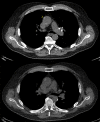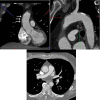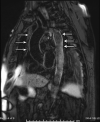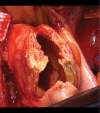Aortic Delamination-A Possible Precursor of Impending Catastrophe
- PMID: 34054275
- PMCID: PMC8159620
- DOI: 10.1055/s-0040-1718546
Aortic Delamination-A Possible Precursor of Impending Catastrophe
Abstract
Aortic diameter is a powerful predictor of adverse aortic events, such as aortic rupture or dissection, forming the basis of prophylactic surgical repair criteria. Limited evidence is available regarding the association of aortic wall thickness (AWT) with these adverse aortic events. We present the case and surgical video of a 73-year-old man with chest pain and an increased AWT, who underwent ascending aortic repair and deep hemiarch placement under deep hypothermic circulatory arrest. Surgical pathology demonstrated evidence of aortic delamination and medial separation, indicative of an impending dissection. The patient recovered uneventfully, and his chest pain ultimately resolved after open repair. In this patient, increased AWT was felt to be the precursor to a potential aortic catastrophe.
Keywords: aortic wall thickness; ascending aorta; delamination; dissection; rupture.
International College of Angiology. This article is published by Thieme.
Conflict of interest statement
Conflict of Interest None declared.
Figures





References
-
- Mensel B, Quadrat A, Schneider T. MRI-based determination of reference values of thoracic aortic wall thickness in a general population. Eur Radiol. 2014;24(09):2038–2044. - PubMed
-
- Elefteriades J A.Natural history of thoracic aortic aneurysms: indications for surgery, and surgical versus nonsurgical risks Ann Thorac Surg 20027405S1877–S1880., discussion S1892–S1898 - PubMed
-
- Elefteriades J A, Farkas E A. Thoracic aortic aneurysm clinically pertinent controversies and uncertainties. J Am Coll Cardiol. 2010;55(09):841–857. - PubMed
-
- Saeyeldin A, Zafar M A, Li Y.Decision-making algorithm for ascending aortic aneurysm: effectiveness in clinical application?J Thorac Cardiovasc Surg2018 - PubMed
-
- Rojo-Leyva F, Ratliff N B, Cosgrove D M, III, Hoffman G S. Study of 52 patients with idiopathic aortitis from a cohort of 1,204 surgical cases. Arthritis Rheum. 2000;43(04):901–907. - PubMed
Publication types
Grants and funding
LinkOut - more resources
Full Text Sources
Other Literature Sources

